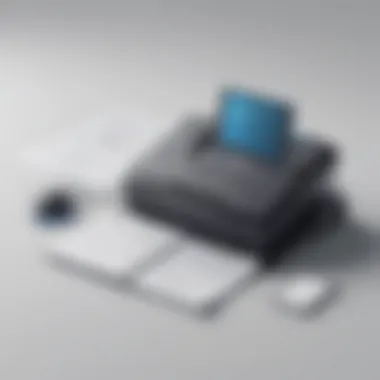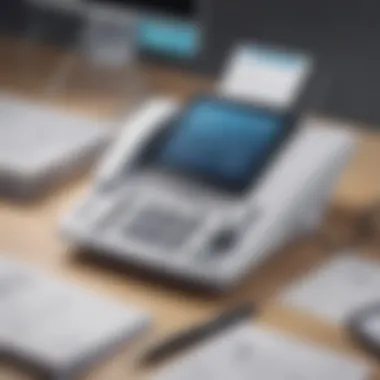Affordable eFax Services: A Comprehensive Guide


Intro
The evolution of communication technology has ushered in the capability of sending documents electronically rather than through traditional fax machines. This development is significant, particularly for small to medium-sized businesses, entrepreneurs, and IT professionals who seek efficient solutions for their operations. eFax services have become a staple in this regard, providing secure, quick, and cost-effective ways to send and receive documents.
Understanding the various affordable eFax services is essential for making informed decisions. The market offers a variety of options that cater to different needs and budgets. This article aims to highlight key factors that influence eFax service costs, outline the benefits of adopting eFax over traditional faxing methods, and analyze leading affordable services available today. By the end of this article, business professionals will have a clearer perspective on integrating eFax technology into their daily functions, thereby enhancing overall productivity.
Software Overview
Purpose of the Software
The primary purpose of eFax software is to facilitate the sending and receiving of faxes over the internet. It eliminates the reliance on physical fax machines, which can be costly to maintain and often fall short in terms of convenience. Users can send attachments via email or a web portal, streamlining the communication process significantly. This is particularly appealing to businesses that prioritize agility and digital transformation in their operations.
Key Features
Many eFax services come equipped with features designed for ease of use and enhanced functionality. Common key features include:
- Email integration: Many eFax solutions allow users to send faxes directly from their email applications, making it a seamless experience.
- Document management: Users can track their sent and received files and access them from various devices.
- Digital signatures: This feature enables users to sign documents electronically, saving time and reducing paper usage.
- Security protocols: Most eFax services prioritize security, employing encryption methods to protect sensitive information.
Comparison with Competitors
Feature-by-Feature Analysis
When considering eFax services, it is crucial to analyze how they stack up against each other based on their features. For instance, some offer better email integration, while others excel in document management capabilities. Users should evaluate their specific needs and compare features accordingly. Services like eFax, MyFax, and RingCentral Fax provide a range of functionalities but differ on various aspects such as user interface, storage capabilities, and support services.
Pricing Comparison
Pricing can vary widely among eFax services. Factors influencing the cost typically include:
- Monthly subscription fees: Most services require a monthly payment for access to their platform.
- Pay-per-use charges: Some also offer pay-as-you-go options, allowing users to pay only for the pages they send or receive.
- Additional features: Extra functionalities like digital signatures or larger storage options may incur additional costs.
A brief overview of pricing for notable eFax services:
| Service Name | Starting Monthly Price | Pay-Per-Use Cost | Key Features | | eFax | $16.99 | $0.10 per page | Unlimited storage | | MyFax | $10.00 | $0.10 per page | 24/7 customer support | | RingCentral Fax | $12.99 | $0.10 per page | Advanced security |
Choosing the right eFax service requires understanding these various aspects thoroughly. Being informed about what each service offers and how much it will cost is invaluable to achieving business efficiency.
"Understanding your eFax service options can mean the difference between inconvenience and seamless communication."
Through examining the features, benefits, and price points, businesses can select an eFax service that aligns with their operational needs and financial constraints.
Preamble to eFax Services
The significance of eFax services in today's business environment cannot be understated. Organizations are constantly in search of solutions that improve efficiency while maintaining cost-effectiveness. The advent of eFax technology has transformed how documents are sent and received, providing several advantages over traditional faxing methods. This section will elaborate on the fundamental concepts surrounding eFax services, highlighting their benefits and contextual relevance in a modern business landscape.
Definition of eFax
Electronic faxing, commonly known as eFax, is a method that allows documents to be sent electronically over the internet rather than through traditional telephone lines. This technology relies on internet-based protocols, enabling users to send and receive faxes via email or online platforms, simplifying the process immensely.
Businesses can avoid the operational costs associated with maintaining physical fax machines, paper, and toner. With eFax, users can digitize their paper documents and send them quickly without the need for manual intervention. This not only saves time but also allows for easier organization and storage of documents.
Evolution of Fax Technology
Fax technology has its roots in the early 19th century, with the first mechanical fax machine being invented by Alexander Bain in 1843. However, it was not until the 1980s that fax machines became commonplace in office environments. Traditional faxing was heavily reliant on physical machines and telephonic connections, which posed various limitations, including the need for dedicated lines and physical space.


The transition to eFax began as internet access proliferated during the late 1990s. This new system offered businesses a more flexible, economical way to manage document transmission. Today, eFax solutions integrate with various software applications that enhance functionality, such as cloud storage services and digital signing tools. This evolution points to a distinct shift toward digital solutions, emphasizing efficiency, convenience, and security in document management.
The Need for eFax in Modern Business
In today's rapidly evolving business environment, the incorporation of eFax systems emerges as a significant necessity. Traditional faxing methods face several limitations that modern businesses cannot afford. eFax not only streamlines communication but also offers a suite of advantages that align with the demands of contemporary operations. Companies increasingly recognize these benefits as crucial for maintaining competitiveness and efficiency.
Cost Efficiency
Cost is a pivotal concern for businesses of any size. eFax services provide an economical alternative to traditional fax solutions, which often rely on physical infrastructure, such as fax machines and dedicated phone lines. Utilizing eFax can significantly reduce operating costs in multiple ways. First, there are no expenses for physical materials like paper and ink. Massive savings can be seen especially in larger organizations, where faxing is frequent.
Additionally, many eFax providers adopt a subscription model, which allows businesses to choose plans that fit their specific needs. This flexibility can minimize wasted resources. Some eFax solutions even offer pay-as-you-go options, ensuring organizations only pay for what they use. This is a sharp contrast to traditional fax, where consistent charges apply regardless of the volume of usage. Thus, cost reduction is not just beneficial; it is often transformative.
Time Savings
In the fast-paced world of business, time has become an essential asset. Using eFax services reduces the time it takes to send and receive documents. Traditional faxing involves physically operating the machine, checking for transmission success, and managing issues like busy signals or paper jams. eFax automates most of this process.
When a document is sent via eFax, it reaches the recipient almost instantly, accelerating workflow. Moreover, the eFax service often provides real-time notifications when a document has been sent and received. This prompt confirmation allows businesses to focus more on their core activities rather than managing delays caused by traditional methods. As a result, eFax not only saves time but also increases productivity across business operations.
Enhanced Security Features
Security has become paramount in professional communication. eFax services address this need effectively. Unlike traditional faxing, where sensitive documents can be mistakenly received or intercepted, eFax employs encryption and secure server storage to protect information. Such features minimize the risk of data breaches, presenting a compelling case for businesses concerned about compliance with regulations like GDPR or HIPAA.
Many eFax services also allow users to implement additional security measures, such as two-factor authentication or password protection. Such customizable security options empower businesses to tailor their faxing solution to meet unique security needs. Therefore, the shift to eFax is not just a technological upgrade; it is a necessary step toward safeguarding sensitive information in today's risk-conscious business landscape.
"Understanding the need for eFax in modern business is essential for maintaining efficiency and security while reducing costs."
Key Features of eFax Services
eFax services offer a variety of qualities that directly affect their usability and attractiveness for businesses. Understanding these features is crucial for making informed decisions about which service best aligns with your operational needs and budget. From document management to accessibility, these aspects define the eFax experience and can enhance productivity in ways that traditional faxing cannot.
Document Management Capabilities
Document management in eFax services allows users to organize, store, and retrieve documents efficiently. This capability can vastly simplify the handling of critical files. Traditional faxes often come with issues of misplacing or losing important documents. In contrast, eFax systems enable users to automate their workflows by categorizing documents and setting up storage protocols.
Moreover, cloud storage integration is often a central feature, making it easier to access documents from any device. This flexibility supports remote working arrangements, which are increasingly common today. Additionally, many eFax services allow users to track sent and received documents, providing transparent record-keeping that is essential for maintaining compliance in many industries.
Multiple File Format Support
A noteworthy advantage of eFax services is the ability to support various file formats. Whether it is PDF, DOCX, or image files like JPEG, the capacity to send and receive in multiple formats caters to a wider range of business needs. This means, when you prepare a document for faxing, you are not restricted to a single file type, allowing for greater compatibility with existing documents.
Such support is particularly beneficial for businesses that handle extensive documentation or require collaboration across different platforms. When eFax services allow file conversion, it saves time and reduces error when preparing documents for transmission. Ultimately, this feature optimizes the entire communication process.
Mobile and Remote Access
eFax services excel in offering mobile and remote access, a critical feature for today’s flexible work environments. Many providers deliver mobile applications that allow users to manage their faxing needs from smartphones or tablets. This setup gives users the freedom to send, receive, and manage faxes on the go. For professionals frequently traveling or working remotely, this functionality is necessary.
The ease of use in these applications cannot be overstated, as they tend to feature user-friendly interfaces. Notifications of incoming faxes or updates on sent documents often reside in a centralized dashboard, ensuring that users remain informed regardless of their location. This shift towards mobile capability reflects broader trends in work culture, emphasizing adaptability and immediacy.
In today's fast-paced business landscape, leveraging technology like eFax can lead to significant time and cost savings.
Overall, these key features function together to provide a holistic eFax experience, making it essential for small to medium-sized businesses, entrepreneurs, and IT professionals to consider when choosing a service. Assessing these functionalities ensures that businesses can remain efficient and responsive in an ever-evolving digital world.
Identifying the Cheapest eFax Services


Finding cost-effective eFax services is essential for small to medium-sized businesses, given the pressures to minimize expenses while maintaining efficiency. Understanding the landscape of affordable options can directly affect a company’s bottom line. Businesses need to grasp which eFax services deliver the functionality they require without the burdensome costs often associated with traditional faxing methods.
The advantages of identifying economical eFax services include enhanced budget management, the ability to allocate resources to other business functions, and access to advanced features without the inflated price tag. In a competitive market, these affordable services allow businesses to innovate and adapt without compromising their financial stability.
Criteria for Selecting eFax Services
When choosing an eFax service, several criteria play a pivotal role in ensuring that businesses derive maximum value. Key factors include:
- Pricing Structure: Is the pricing transparent? Are there hidden fees? Understanding the full breakdown helps in assessing the total cost.
- Usability: An intuitive interface enhances user experience, allowing employees to integrate eFax seamlessly into daily operations.
- Customer Support: Reliable customer service is vital. Fast response times and knowledgeable staff can alleviate potential issues quickly.
- Integration Capabilities: Can the service easily integrate with existing software or systems, like email and cloud storage?
- Security Measures: Given the sensitive nature of documents, robust security protocols are non-negotiable. Check if there are encryption standards in place.
Ultimately, these criteria empower businesses to make informed decisions that align with their operational needs and budget constraints.
Market Overview of Affordable Options
The market for eFax services is increasingly saturated with various providers that cater to budget-conscious users. Notable players offer competitive packages, emphasizing both affordability and quality. Services such as eFax, MyFax, and Fax.Plus have made their presence known by providing accessible plans that suit businesses of all sizes.
With the rising demand for digital solutions, these platforms constantly evolve, introducing features that enhance their appeal. Options vary from pay-as-you-go plans to monthly subscriptions. As a result, business professionals have the flexibility to choose what best suits their needs without overspending.
It is advisable to periodically review these offerings, as market dynamics can shift quickly, leading to better deals or innovative features.
Comparison of Pricing Plans
A critical step in identifying the best eFax service is to closely compare pricing plans offered by various providers. While some may have low base fees, others offer more pages for the same price, increasing overall value. Common pricing tiers include:
- Basic Plans: Ideal for infrequent fax users, typically offering limited pages per month at a lower cost.
- Mid-Tier Plans: More suitable for regular users, including additional features like mobile access and enhanced security, with a reasonable number of included pages.
- High-Volume Plans: Designed for large organizations that require extensive faxing capabilities, often providing customizable solutions.
Comparison tools online can provide insights into monthly costs and included services, making it easier to visualize which provider aligns with specific requirements.
Understanding different pricing plans is crucial for selecting an economical option that fulfills both current and future business needs.
Top Affordable eFax Providers
Identifying the best affordable eFax providers is paramount for businesses looking to optimize their communication while keeping costs under control. With the increasing reliance on digital processes, a diverse range of eFax services has emerged. These options not only enhance operational efficiency but also offer financial advantages that can significantly impact the bottom line.
When selecting an eFax provider, it is important to consider not only the pricing but also the features that are included. Some vital elements include file format compatibility, user-friendly interfaces, and customer support services. Understanding these can help businesses make an informed choice that aligns with their operational demands.
Provider A: Overview and Pricing
Provider A offers flexible pricing plans designed to accommodate various business needs. Their entry-level plan starts at a competitive price, making it accessible for small businesses. They provide features such as secure document transmission, multiple file format support, and a user-friendly mobile app. The pricing structure is straightforward, and there are no hidden fees, allowing users to budget effectively. Overall, Provider A is an attractive option for businesses seeking economical solutions.
Provider B: Overview and Pricing
Provider B distinguishes itself with robust technical support and various pricing tiers. Their plans range from budget-friendly options to more comprehensive packages. Noteworthy features include high-volume faxing and proactive customer service availability. Businesses can start with a low-cost plan and scale up as their needs evolve. This flexibility enhances their appeal, particularly for growing companies.
Provider C: Overview and Pricing
Provider C is recognized for its extensive integrations with popular business applications. They present a range of pricing options, catering to both individual users and larger teams. The inclusion of advanced features such as electronic signatures sets them apart from competitors. Although the pricing may be slightly higher than others, the value provided might justify the investment. It is essential for businesses to assess whether such features align with their requirements before making a decision.
"Selecting the right eFax provider can shape how effectively a business communicates. Evaluating features alongside pricing is crucial to meet specific needs without overspending."
Evaluating eFax Service Performance
In the realm of eFax services, evaluating performance is crucial for businesses seeking effective communication solutions. Finding the right eFax provider goes beyond just cost; it involves assessing how well the service meets user needs. Key factors include reliability, speed, security, and user-friendly features. A comprehensive evaluation allows businesses to select a provider that aligns with their operational requirements and long-term goals.


Performance evaluation helps identify strengths and weaknesses in eFax services. It ensures that businesses are not only getting a good price but also value in functionality. A poor performance can lead to frustrations, such as missed deadlines or lost documents, potentially harming business operations. Understanding this is vital for small to medium-sized businesses, entrepreneurs, and IT professionals looking to optimize their communication strategies.
User Reviews and Testimonials
The insights from user reviews and testimonials serve as valuable resources for evaluating eFax services. Real-life experiences provide context that goes beyond marketing claims. They help potential users understand how a service performs in actual scenarios, affecting practical aspects like:
- Reliability: Reviewers often share their experiences regarding how consistently a service works without errors.
- Ease of Use: Users highlight if the interface is intuitive or if there are frequent challenges in navigation.
- Execution Speed: Feedback on how quickly faxes are sent or received can impact decisions, especially for businesses that prioritize swift communication.
While reviews can provide important information, they should be analyzed critically. It is useful to look for patterns or recurring themes. A single negative review should not deter a decision without considering the overall sentiment.
"The best way to determine the efficacy of an eFax provider is through community feedback. It's the real-world applications that speak volumes."
Technical Support and Customer Service
In addition to user reviews, effective technical support and customer service are essential components of evaluating eFax service performance. A responsive support system can alleviate issues that arise during use. Factors to consider include:
- Availability: Is customer support accessible 24/7 or only during business hours? This matters for businesses that operate outside typical hours.
- Channels of Communication: Does the provider offer multiple contact options, such as chat, email, or phone support? This increases accessibility for users.
- Problem Resolution Time: Users should assess how quickly common issues are addressed. Long wait times can disrupt operations and affect productivity.
Robust technical support ensures that potential problems are resolved efficiently, promoting greater reliability in the service. Businesses that prioritize these elements can often make smoother transitions into eFax technology.
Alternatives to eFax Services
With the rapid advancement of technology, businesses often explore various methods for document transmission. While eFax services offer numerous advantages, it is equally important to understand the alternatives available. This section outlines traditional and hybrid solutions, providing a clear picture of how they compare against eFax services in terms of functionality, cost, and usability.
Traditional Fax Solutions
Despite the prevalence of digital solutions, traditional fax machines still play a role in some businesses. Companies that maintain fax machines often rely on them due to familiarity or specific regulatory requirements that demand paper records. That said, traditional faxing does have notable limitations.
- Cost Implications: Traditional fax machines incur costs such as paper, ink, and maintenance. The overall expense can be significant over time.
- Efficiency Issues: Sending and receiving documents through a physical machine can be slow. It may require employees to spend excessive time waiting for transmissions.
- Limited Mobility: Traditional fax requires physical presence in the office to send documents. This restricts remote collaboration, a crucial factor for many modern businesses.
- Security Risks: Paper faxes can be vulnerable to interception or misdelivery. Sensitive information may be exposed if not handled securely.
These challenges highlight the need for businesses to reconsider their reliance on traditional methods, especially when more efficient options like eFax are available.
Hybrid Fax Solutions
Hybrid fax solutions attempt to combine the best of both worlds. They enable users to benefit from both traditional fax technology and digital capabilities. A hybrid approach allows companies to receive faxes via their email, while still having the option to print hard copies if necessary. Here are some key benefits of hybrid fax solutions:
- Flexibility: Users can choose whether to transmit documents digitally or through physical methods, depending on the situation or the recipient’s preference.
- Cost Savings: By minimizing reliance on paper and ink, businesses can potentially lower their operational costs. These solutions often offer competitive pricing compared to traditional fax machines.
- Integration with Digital Platforms: Hybrid fax systems can integrate with existing email clients or document management systems, simplifying workflow and maintaining records more efficiently.
- Improved Security: Digital transmission reduces the risks associated with paper documents. Hybrid solutions often include encryption, ensuring that sensitive documents remain protected during transmission.
The introduction of hybrid fax services presents a compelling argument for businesses still relying on traditional fax methods. In any scenario, understanding the implications of adopting eFax services or their alternatives is essential. By comparing these options, organizations can make informed decisions tailored to their specific needs.
Ending
In today's business environment, the utilization of eFax services has become increasingly relevant. As organizations seek cost-effective and secure solutions to communicate, eFax offers a blend of traditional convenience and modern technology. The necessity for electronic communication has shifted from optional to crucial, particularly for small to medium-sized businesses that must maintain competitiveness in a digital landscape.
Summarizing the Importance of eFax
eFax services bridge the gap between traditional faxing and the digital age. They provide a range of benefits that are hard to overlook. Cost efficiency is a prominent feature, as companies can avoid ongoing expenses associated with fax machines, paper, and ink.
Furthermore, eFax enhances security for sensitive communications, utilizing encryption protocols to safeguard information. This aspect is a major consideration, especially in industries that handle private data, such as healthcare or finance. In addition, the time savings from streamlining document transmission processes enable businesses to collaborate more effectively.
Ultimately, adopting eFax technology can facilitate a transition to more environmentally friendly practices, reducing paper use significantly, a consideration that aligns with the growing societal push for sustainability.
Future Trends in eFax Technology
The future of eFax technology is poised for exciting developments. As digital transformation accelerates, trends indicate that eFax services will become more integrated with cloud-based document management systems. This integration means that sending and receiving faxes will continue evolving into an even more seamless experience.
Artificial intelligence might also play a role in the future. Anticipated advancements include automated sorting of faxes and intelligent indexing, enabling faster retrieval and response times.
Moreover, the ongoing concerns surrounding cybersecurity will drive eFax providers to continuously enhance their features, ensuring compliance with stringent regulations. Such improvements will help businesses navigate the complexities of data protection while utilizing eFax functionalities.



